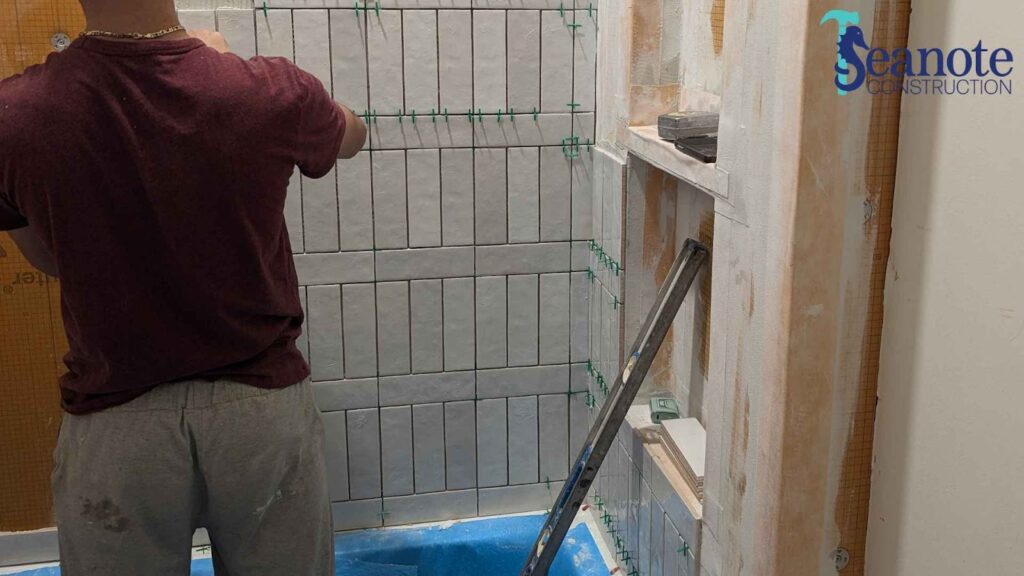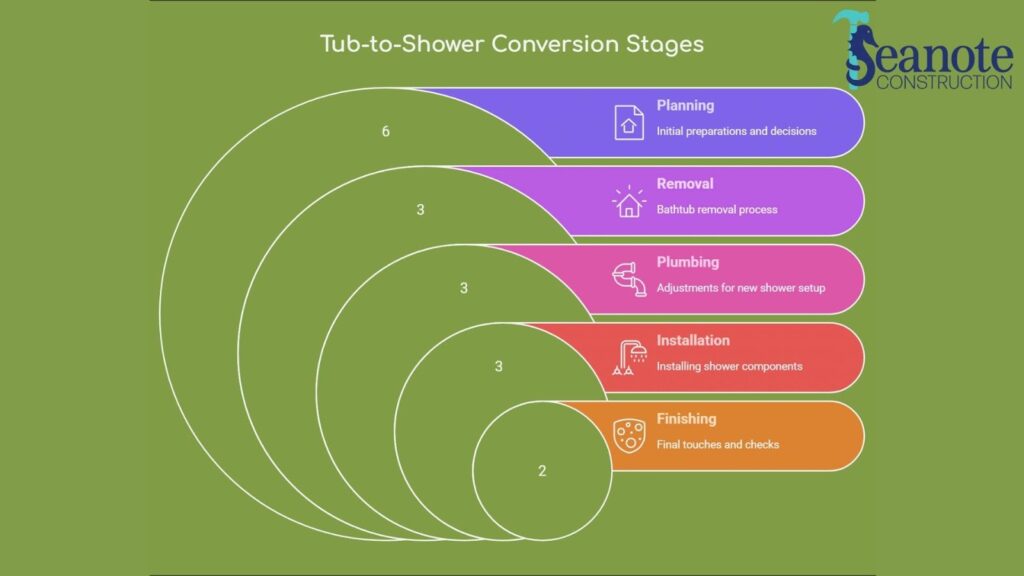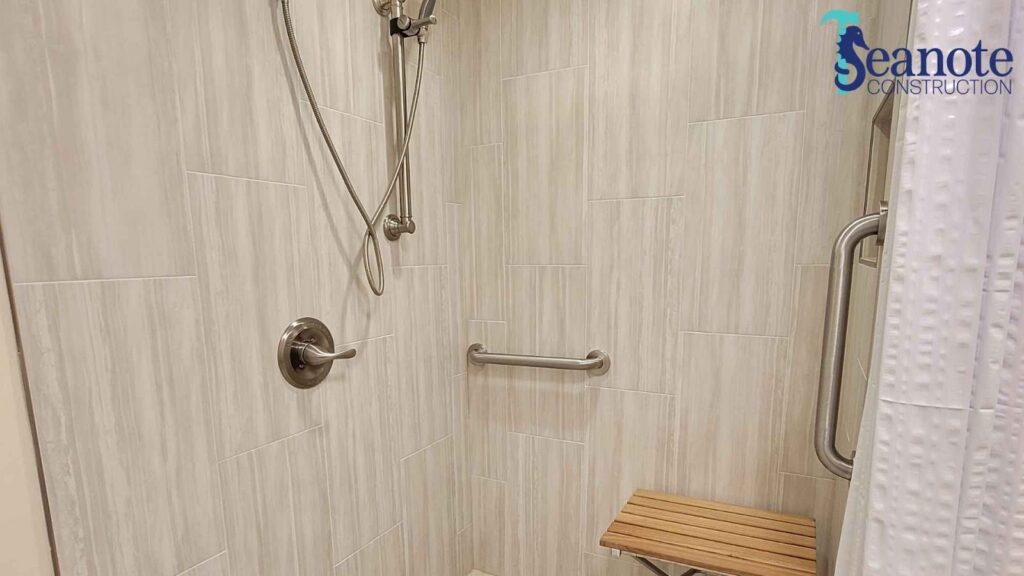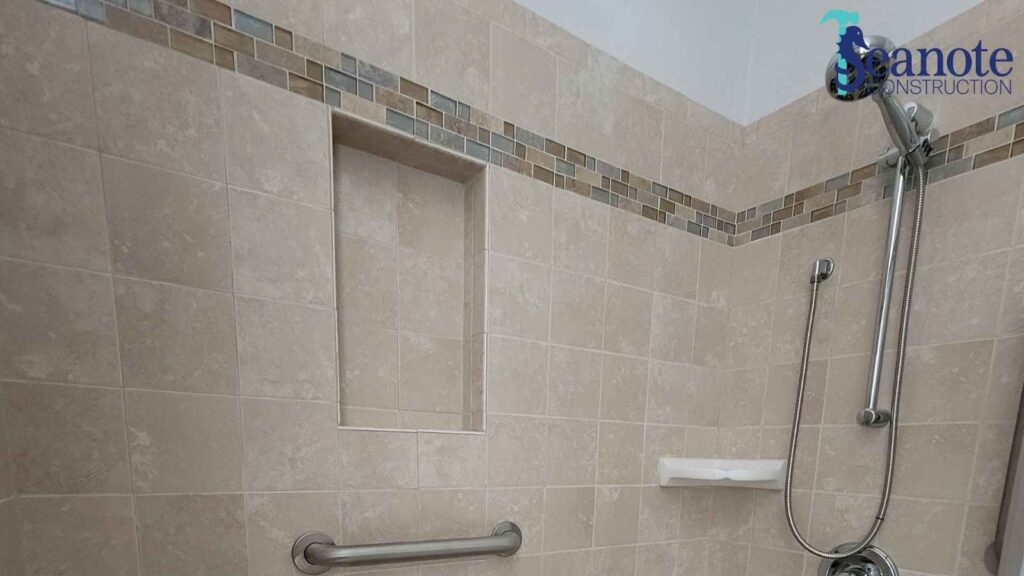A tub that never gets used is just wasted space. Showers are practical, easier to clean, and can make a bathroom feel bigger. Fully understanding the process of removing your tub and replacing it with a shower can help prevent unexpected costs or headaches down the line.
According to HomeAdvisor, 31% of households that completed a home improvement project focused on a bathroom remodel. A tub-to-shower conversion lets homeowners add value to one of the most utilized spaces in any home.
Seanote Construction provides clear communication, solid work, and full accountability. We take on the tough jobs, stay organized, and keep pricing transparent from start to finish.
Key Takeaways
- A tub-to-shower conversion adds convenience but may impact resale if it’s your only tub.
- Costs range from $1,000 (DIY) to $10,000+ (custom remodel).
- The process includes tub removal, plumbing adjustments, and shower installation.
- DIY saves money but risks mistakes, while professionals offer speed, quality, and warranties.
What is a Tub-to-Shower Conversion?
A tub-to-shower conversion is removing a bathtub and replacing it with a shower. This could mean a walk-in shower with a sleek glass enclosure or a simple tiled space with a curtain. Homeowners want modern, low-maintenance spaces, and removing an unused bathtub is often the easiest way to achieve that.
Why are Conversions so Popular?
Bathtubs take up space, and many people rarely use them. A shower, on the other hand, is easier to clean and makes a bathroom feel more open and updated.
Some of the biggest reasons homeowners make the switch:
- More Convenience: Showers fit busy lifestyles better than bathtubs.
- Better for Small Bathrooms: A shower creates more usable floor space.
- Easier to Clean: No more scrubbing around a bulky tub.
- Aging & Accessibility: Walk-in showers are safer for older adults or anyone with mobility concerns.
- Modern Aesthetic: Frameless glass and tiled showers look sleek and contemporary.
Does a Tub-to-Shower Conversion Increase Home Value?
In most cases, yes, a modern, well-done shower remodel can boost resale value. Many homebuyers prefer showers over tubs, especially in smaller bathrooms or master suites.
But there’s one exception. If you only have one bathroom in the house, removing the only bathtub could make it harder to sell later. One tub per home is best practice for resale since families with young children often need a tub.
How Much Does a Tub-to-Shower Conversion Cost?

The cost of converting a bathtub into a shower varies widely. Based on data from HomeAdvisor, most homeowners spend between $1,500 and $8,000 on this type of remodel, depending on materials and labor. If you’re looking for a high-end custom shower, expect to pay even more, especially if plumbing changes are needed.
Average Cost Breakdown
| Conversion Type | Average Cost | Key Factors |
| DIY Basic Conversion | $1,000 – $3,500 | Uses pre-made kits, no major plumbing changes |
| Standard Professional | $3,500 – $8,000 | Includes labor, mid-range materials, minor plumbing work |
| Luxury Custom | $10,000+ | High-end finishes, new plumbing, custom tile |
What Affects the Cost?
Here are the key elements that affect cost:
- Materials: Acrylic and fiberglass are cheaper than custom tile.
- Labor: DIY is cheaper but riskier. Hiring a pro costs more but can offer higher quality.
- Plumbing: Moving drains or pipes adds hundreds to thousands in costs.
- Permits: Some cities require permits, adding fees.
- Extras: Frameless glass, built-in storage, and premium fixtures increase costs.
How to Save Money
Here are some way your can keep costs down during your conversion:
- Use a shower conversion kit instead of custom tile.
- Keep plumbing in place to avoid costly adjustments.
- DIY the demolition to cut labor costs.
- Choose fiberglass or acrylic walls instead of tile.
How to Convert a Bathtub into a Shower: Step-by-Step Guide

A standard tub-to-shower process generally takes between 3 to 7 days when handled by professionals. DIY projects may take longer, especially if plumbing adjustments or waterproofing are involved. Here’s how it’s done.
Step 1: Plan and Budget
- Measure your space to confirm a proper fit.
- Decide on materials (shower kit vs. custom tile).
- Check if a permit is required in your area.
- Get contractor quotes if hiring a pro.
Step 2: Remove the Bathtub
- Turn off the water and disconnect plumbing.
- Cut and remove the tub (may require breaking it apart).
- Dispose of old materials properly.
Step 3: Adjust Plumbing and Drainage
- Check if the drain needs moving to match the shower base.
- Replace or extend water lines if needed.
- Install a new shower valve (adjust height if necessary).
Step 4: Install the Shower Base and Walls
- Set the shower pan securely with mortar for stability.
- Install waterproof wall panels or backer board if using tile.
- Seal all seams and joints to prevent leaks.
Step 5: Install Fixtures and Enclosure
- Attach the showerhead and faucet according to manufacturer instructions.
- Install a glass door, depending on the design.
Step 6: Seal and Finish
- Caulk all edges to prevent moisture issues.
- Check for leaks before finalizing the installation.
Best Tub-to-Shower Conversion Ideas & Inspiration
Here are some of the best ideas to inspire your remodel:
- Corner Showers: Maximize floor space with a compact neo-angle or curved glass design.
- Frameless Glass: Makes the space feel larger without bulky enclosures.
- Built-in Niches: Recessed shelves eliminate clutter and keep products off the floor.
- Light Tile Colors: White, beige, or light gray tiles create an open, airy look.
What’s Trending in Bathroom Remodels?
- Matte Black Fixtures: Sleek, modern, and pairs well with any style.
- Rainfall Showerheads: A spa-like experience at home.
- Large Tiles: Fewer grout lines mean easier cleaning.
- Smart Showers: Temperature control and digital presets for a high-tech touch.
How Can You Make Your Shower Safer for Aging?

As one gets older, it’s important that your shower grows with you. Here are some ways to make your shower safer for the elderly.
- Curbless Entry: No step to trip over.
- Grab Bars: Essential for stability.
- Slip-Resistant Flooring: Textured tile or anti-slip coatings prevent falls.
- Handheld Showerheads: Adjustable height and flexibility make washing easier.
DIY vs. Hiring a Contractor: Which One Is Best for You?
While DIY can save money, most homeowners still prefer to hire professionals for bathroom remodels. A 2024 survey from Clever Real Estate found that 58% of homeowners hired pros for bathroom renovations, while 42% attempted DIY.
If you have plumbing experience, DIY might be an option, but hiring a contractor makes sure the job is done quickly and correctly.
| Factor | DIY Installation | Professional Installation |
| Cost | Lower ($1,000–$3,500) | Higher ($3,500–$10,000+) |
| Skill Level | High skill level required for plumbing & tiling | A professional has all the required skills |
| Time Required | 1–3 weeks (depends on experience) | 3–7 days |
| Risk of Mistakes | High (potential leaks, drainage issues) | Low (done by licensed pros) |
| Warranty | No warranty, DIY fixes | Covered by contractor |
Risks of a DIY Tub-to-Shower Conversion
There can be hidden risks when attempting a DIY conversation:
- Hidden Plumbing Issues: If pipes need moving, DIY gets complicated fast.
- Waterproofing Mistakes: Poor sealing leads to mold and structural damage.
- Longer Timeline: A pro can finish in days; DIY can take weeks.
When Should You Hire a Professional?
If you need the following, you should hire a professional:
- You need plumbing or drain adjustments.
- You want a warranty on the work.
- You don’t have time for trial and error.
Frequently Asked Questions (FAQs)
Q: Do You Need a Permit for a Tub-to-Shower Conversion?
Yes, if plumbing is moved. Check local codes or ask your contractor.
Q: Can You Convert a Tub to a Shower Without Moving Plumbing?
Yes, if the shower is installed where the tub was. Moving pipes adds cost.
Q: Does a Tub-to-Shower Conversion Affect Resale Value?
Yes, it can increase resale value. However, every house should have at least one tub.
Get the Shower You Actually Want Without the Guesswork
A tub-to-shower conversion should be simple with clear pricing, quality work, and no surprises. At Seanote Construction, we take on the tough jobs, stand behind our work, and keep you informed every step of the way. If something’s not right, we fix it, no runaround, no excuses.
Have questions or want a quote? Contact us and get started with a team that tells it like it is.

